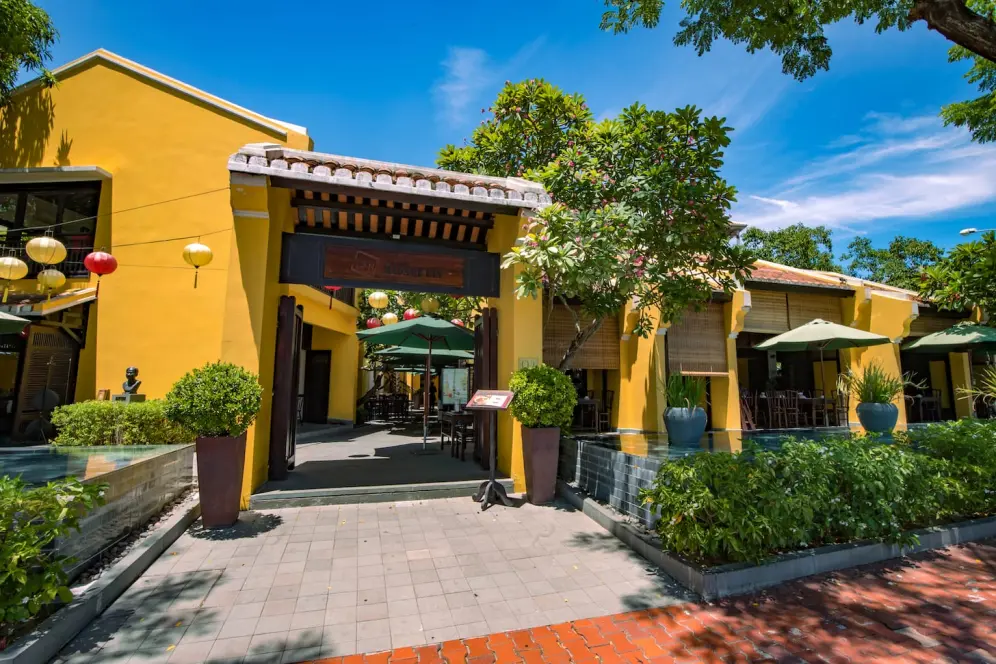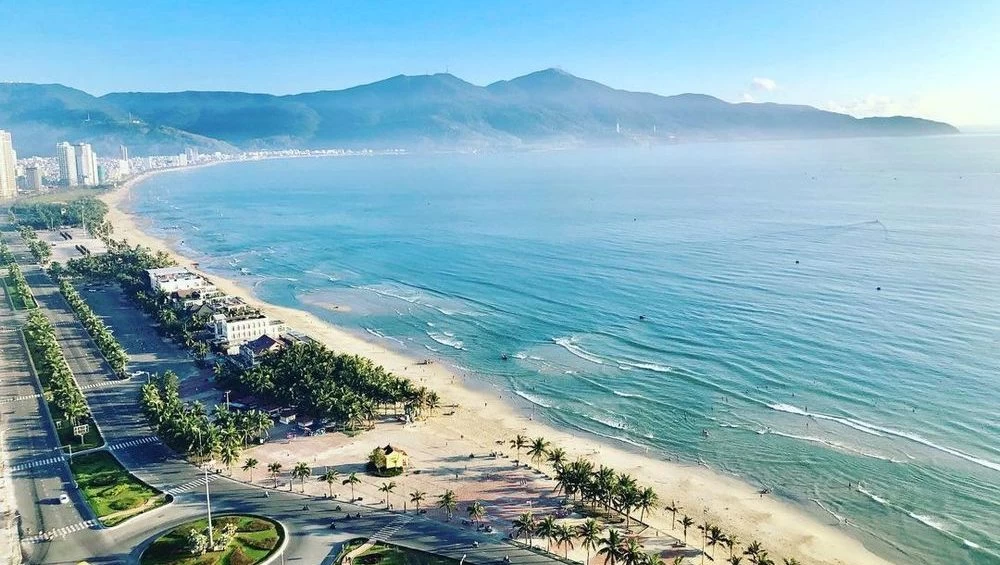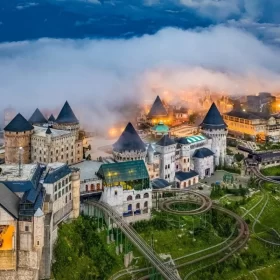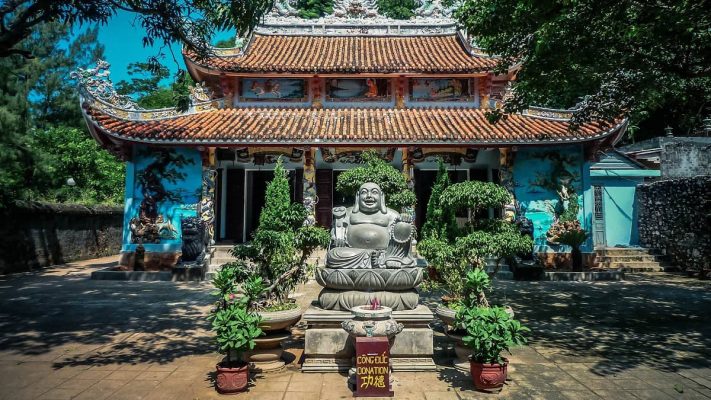
Tam Thai Pagoda – The oldest pagoda in Da Nang
Explore the rich cultural tapestry of Tam Thai Pagoda, nestled in the scenic Marble Mountains of Da Nang, Vietnam. This historic site blends traditional Vietnamese architectural styles with Buddhist influences. Discover intricate sculptures, serene courtyards, and the spiritual essence of this national cultural heritage. Ideal for history enthusiasts and spiritual seekers alike, plan your visit to Tam Thai Pagoda with Ula Travel today for an unforgettable cultural experience.
I. Overview of Tam Thai Pagoda
Nestled within the scenic Marble Mountains, Tam Thai Pagoda stands as a testament to the region’s rich cultural and historical heritage. This ancient pagoda, with its serene ambiance and stunning architectural details, offers a unique glimpse into Vietnam’s Buddhist traditions and history.
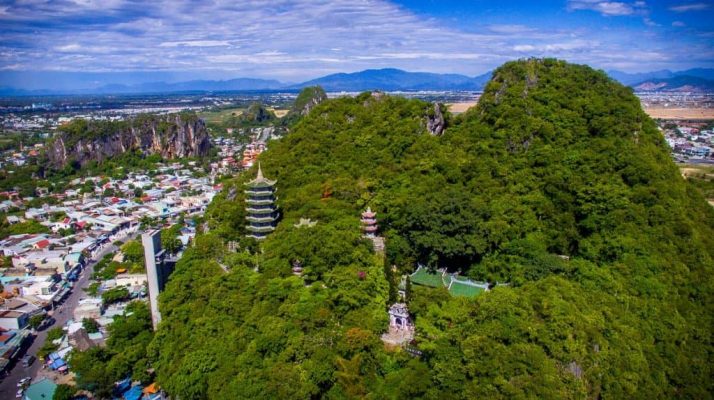
Tam Thai Pagoda is located in the Marble Mountains complex
Located amidst the lush greenery and dramatic limestone formations of the Marble Mountains, Tam Thai Pagoda is a must-visit destination for tourists seeking both spiritual solace and historical insights. The pagoda is situated on Water Mountain, the most famous and picturesque of the five mountains that make up the Marble Mountains. Visitors can reach Tam Thai Pagoda by ascending a series of stone steps that wind their way up the mountain, offering breathtaking views of the surrounding landscape.
II. Historical Background of Tam Thai Pagoda
1. Construction History
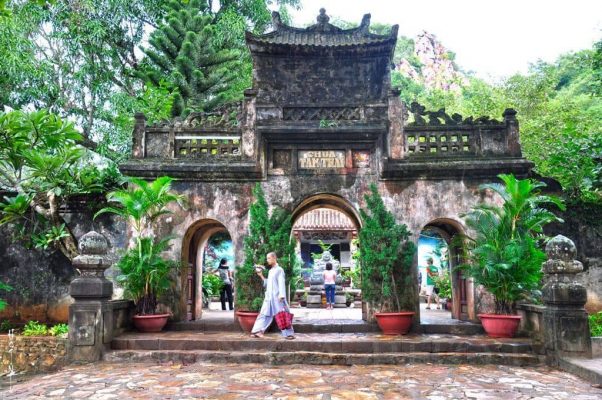
Tam Thai Pagoda was built in the early 17th century
The pagoda was first built in 1630 under the name Tam Thai Pagoda. It was led by a Chinese Zen master named Hung Lien in the Northern Buddhist tradition. In 1825, during the reign of King Minh Mang, the pagoda was reconstructed with significant changes to its appearance.
Over the years, it underwent several renovations, notably from 1907 to 1995. In 1901, it was damaged by the Tan Suu storm and subsequently rebuilt in 1907. In 1995, Venerable Thich Tri Giac renovated the pagoda, orienting its facade to the south and roofing it with two-tiered tiled roofs adorned with ornate dragon-shaped decorations.
Currently, the pagoda still preserves the Tam Thai Tu signboard and a stone stele engraved with a flaming heart motif inscribed by Emperor Minh Mang, praising the boundless compassion and salvation of sentient beings according to Buddhist teachings.
2. Local Cultural Significance
Tam Thai Pagoda has played a pivotal role in the history and culture of the local community. Several cultural practices are associated with the pagoda:
- Buddhist Festivals and Ceremonies: Over the centuries, Tam Thai Pagoda has been a focal point for major Buddhist festivals and ceremonies. These events attract pilgrims and visitors from across the region, highlighting the pagoda’s religious significance.
- Cultural Hub: The pagoda has also been a center for cultural activities, including traditional music performances, poetry readings, and educational gatherings. It has nurtured and preserved local cultural traditions, making it an essential part of the community’s heritage.
III. Unique Architecture of Tam Thai Pagoda
1. A Wonderful Fusion of Buddhism and Traditional Architecture
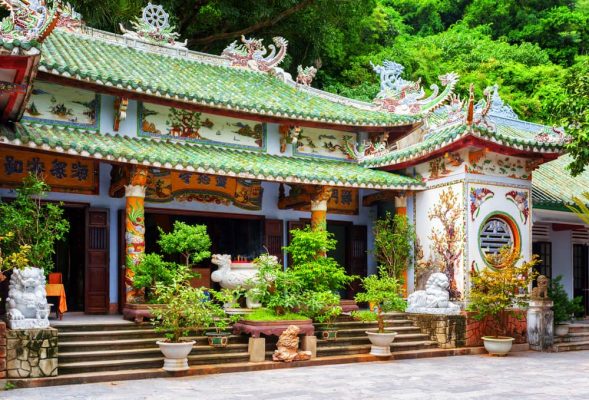
The special architecture of Tam Thai Pagoda
Tam Thai Pagoda is a beautiful blend of traditional Vietnamese architecture and Buddhist elements. The pagoda’s design reflects the harmony between nature and spirituality, featuring intricate wooden carvings, curved roofs, and delicate ornamentation that are characteristic of traditional Vietnamese architecture. The influence of Buddhism is evident in the serene ambiance, the layout of the temple grounds, and the various religious symbols and statues present throughout the site.
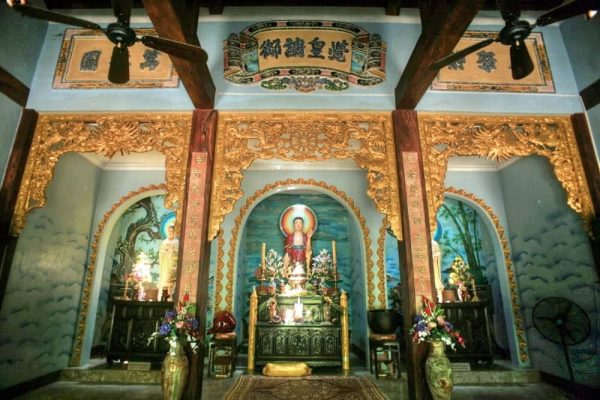
Inside Tam Thai Pagoda
Tam Thai Pagoda is constructed with a majestic and splendid three-tier architecture. The first tier, facing north, is called Thuong Thai; the second tier, facing south, is called Trung Thai; and the third tier, facing east, is called Ha Thai.
The pagoda’s architecture follows the shape of the character “King” in Chinese characters, characterized by artistic and highly aesthetic lines. Outside, the entrance is adorned with a triple gate resembling a bell tower with tiled roofs, giving it a very ancient and dignified appearance.
Are you looking for: Da Nang tours
2. Main Structures
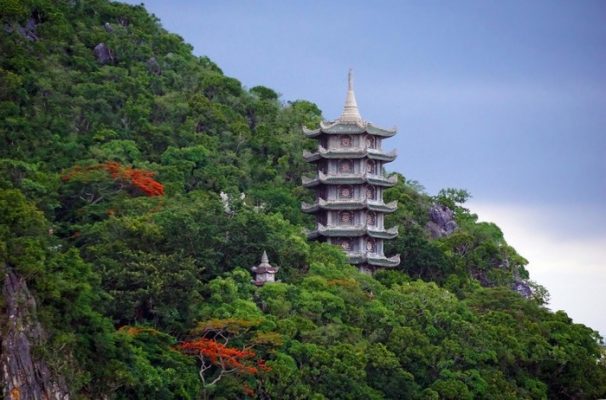
Tower of Relics
- Tam Thai Pagoda: The main structure of the complex, the pagoda, is a three-tiered temple that exudes tranquility and reverence. Each tier represents different aspects of Buddhist teachings and practices. The central hall houses an impressive statue of Buddha, surrounded by offerings and incense, creating a peaceful atmosphere for prayer and meditation.
- Tower of Relics: This towering structure is a significant highlight of the pagoda. The tower, also known as the Stupa, is dedicated to the relics of Buddha and is a symbol of enlightenment. It stands tall, offering visitors a panoramic view of the surrounding area, including the lush greenery of the Marble Mountains and the scenic beauty of Da Nang.
- Buddha Statues: Scattered throughout the pagoda complex are numerous statues of Buddha in various postures, each symbolizing different teachings and moments from the life of Buddha. These statues are meticulously crafted, showcasing the artistry and devotion of the craftsmen.
3. Artistic Works
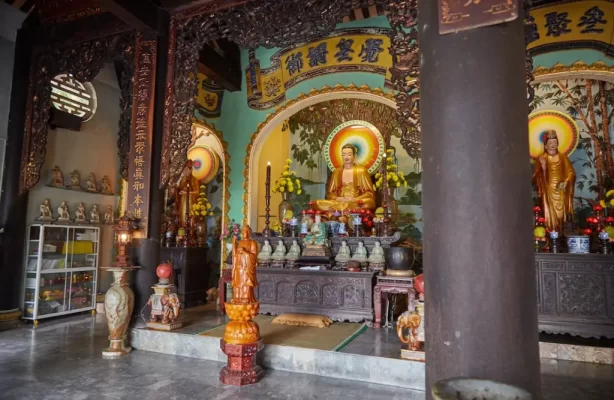
The wood is exquisitely carved
- Wood Carvings: Intricate wooden carvings can be found on doors, pillars, and beams, depicting scenes from Buddhist mythology, floral patterns, and symbolic animals. These carvings are not only decorative but also convey deep spiritual meanings.
- Frescoes: The walls of the pagoda are decorated with vibrant frescoes that illustrate stories from Buddhist scriptures. These paintings, with their rich colors and detailed depictions, serve both as educational tools and as a source of inspiration for visitors.
- Bas-reliefs: The pagoda also features stunning bas-reliefs, which are shallow sculptures carved into the stone surfaces. These bas-reliefs depict various deities, historical figures, and mythical creatures, adding to the temple’s rich tapestry of religious and cultural narratives.
IV. Cultural Significance of Tam Thai Pagoda
1. Religious Role – A Place for Prayer
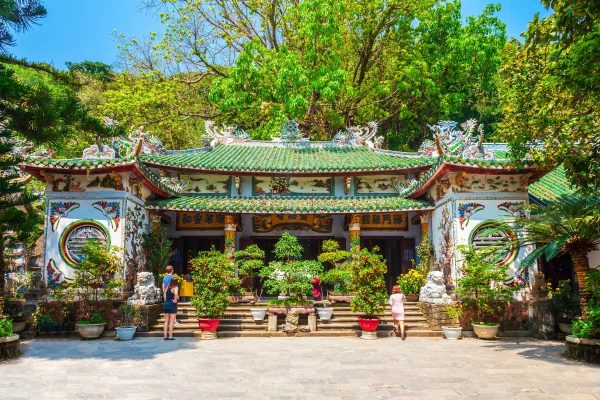
People often go to the temple to pray for peace
Tam Thai Pagoda holds a vital role in the spiritual lives of local Buddhists. It serves as a place for monks and nuns to practice their faith, meditate, and conduct religious ceremonies. For laypeople, the pagoda is a sanctuary where they can pray, seek spiritual guidance, and make offerings. The serene and sacred environment of Tam Thai Pagoda provides a tranquil space for contemplation and devotion, reinforcing its importance in the daily religious practices of the community.
Do not miss: Da Nang to Hue – Unexpected Trip You’ll Love
2. Celebrating Buddhist Traditions
Throughout the year, Tam Thai Pagoda is the site of various religious festivals and events that attract both locals and tourists. Key Buddhist holidays such as Vesak (the Buddha’s birthday), Vu Lan (the Buddhist All Souls’ Day), and Tet Nguyen Dan (Lunar New Year) are celebrated with grand ceremonies, rituals, and cultural performances.
These festivals offer visitors a unique opportunity to experience the rich traditions and vibrant atmosphere of Vietnamese Buddhist culture. Traditional music, dance, and processions are often part of these celebrations, providing a deeper understanding of the local customs and religious practices.
Start your journey with: Da Nang to Hoi An in 4 Days
3. Recognized National Historical and Cultural Site
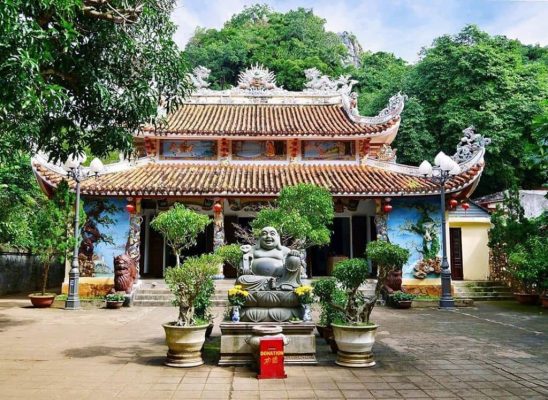
This ancient temple is a national historical and cultural relic
Tam Thai Pagoda is not only a religious site but also a significant cultural heritage landmark. It has been recognized as a national historical and cultural site by the Vietnamese government, highlighting its importance in the cultural landscape of the country.
The pagoda’s architecture, art, and history reflect the rich cultural and spiritual heritage of Vietnam. Preserving this site ensures that future generations can continue to learn about and appreciate the traditions and history associated with it.
The designation as a national historical and cultural site underscores the pagoda’s value and significance, making it a must-visit destination for anyone interested in the cultural heritage of Vietnam.
Read more: Da Nang Culture
V. Useful Information Tourists Need to Know
1. Directions from Da Nang City Center
Tam Thai Pagoda is located about 10 kilometers southeast of Da Nang city center, nestled within the Marble Mountains. The journey to the pagoda can be easily accomplished by various means:
- By Car or Taxi: A taxi or private car ride from Da Nang city center to Tam Thai Pagoda typically takes around 20–25 minutes. The most direct route is via Vo Nguyen Giap Street, which offers a scenic coastal drive.
- By Motorbike: For the more adventurous, renting a motorbike is a popular choice. Follow Vo Nguyen Giap Street south along the coast, then turn inland towards the Marble Mountains. Ample parking is available at the site.
- By Bus: Public buses also serve the route. Take bus number 1 from the city center towards Hoi An and alight at the Marble Mountains stop. From there, it’s a short walk to the entrance.
2. Opening hours and admission fees
- Opening Hours: Tam Thai Pagoda is open daily from 7:00 a.m. to 5:00 p.m. Visiting in the early morning or late afternoon is recommended to avoid the heat and enjoy a quieter atmosphere.
- Admission Fees: Entry to Tam Thai Pagoda is free. However, there is a small fee (approximately 40,000 VND, around $1.75) for access to the Marble Mountains area, which includes several other temples, caves, and viewpoints.
3. Interesting Experiences for visitors
- Sightseeing: Explore the serene pagoda grounds, featuring beautiful courtyards, intricate carvings, and ancient bonsai trees. Don’t miss the main hall, where you can see impressive statues and altars.
- Photography: The architectural beauty and the surrounding natural landscape provide excellent photo opportunities. Capture the intricate details of the pagoda and the panoramic views from the mountain.
- Learning History and Culture: Informative plaques and guides are available to help visitors understand the historical and cultural significance of Tam Thai Pagoda. Engaging with local guides can enhance this experience.
- Meditation and Reflection: Many visitors come to the pagoda to meditate and reflect in a tranquil setting. The peaceful environment is ideal for those seeking spiritual renewal.
4. Local Tourism Culture
- Dress Code: Visitors are expected to dress modestly out of respect for the sacred nature of the site. Shoulders and knees should be covered, and hats should be removed before entering any temple buildings.
- Behavior: Maintain a quiet and respectful demeanor. Avoid loud conversations and keep your mobile phone in silent mode. Do not touch religious statues or artifacts.
- Photography Rules: While photography is generally allowed, always ask for permission before photographing monks or worshippers. Some areas might have restrictions on flash photography.
- Environmental Respect: Help preserve the beauty of the site by not littering. Use designated trash bins and avoid touching or damaging plants and structures.
VI. Tourist Destinations Near Tam Thai Pagoda
1. Marble Mountains
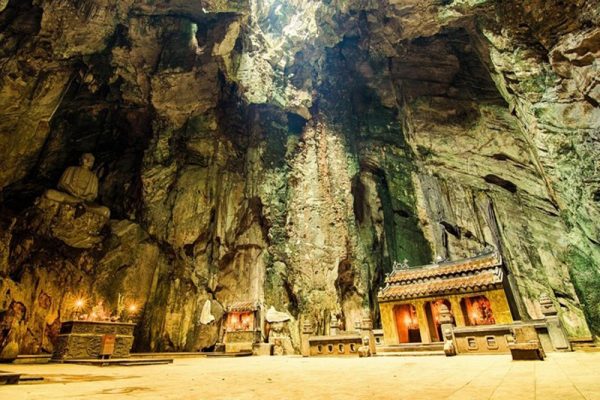
Marble Mountains
The Marble Mountains are a cluster of five marble and limestone hills named after the five elements: Kim (metal), Thuy (water), Moc (wood), Hoa (fire), and Tho (earth). This scenic spot is known for its numerous caves, tunnels, and temples, offering a blend of natural beauty and cultural heritage.
Activities:
- Exploration: Wander through the intricate cave systems, including Huyen Khong Cave and Tang Chon Cave, each with its own unique features and historical significance.
- Temple Visits: Visit the various pagodas and shrines, such as Linh Ung Pagoda and Tam Thai Pagoda, each rich with history and spiritual ambiance.
- Hiking: Climb the stone steps to reach the peaks of the mountains for breathtaking panoramic views of the surrounding landscape.
Highlights:
- Huyen Khong Cave is known for its large cavern and spiritual atmosphere, often illuminated by natural light streaming through openings in the cave.
- Linh Ung Pagoda: A serene temple complex with impressive statues and peaceful gardens.
- Panoramic Views: Stunning views from the peaks of the Marble Mountains, including vistas of the coastline and Da Nang city.
You will be like: Discover Central Vietnam Tour in 6 Days
2. Non Nuoc Stone Carving Village
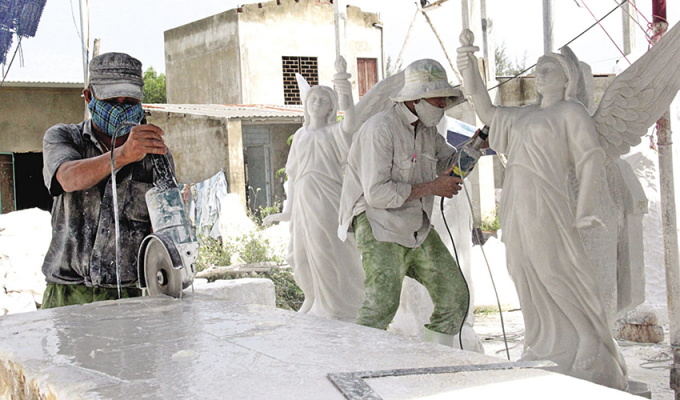
Non Nuoc Stone Carving Village
Situated at the foot of the Marble Mountains, Non Nuoc Stone Carving Village is renowned for its skilled artisans who have been crafting intricate stone sculptures for centuries. The village is a hub of traditional craftsmanship, producing everything from small souvenirs to large statues.
Activities:
- Workshop Tours: Visit local workshops to see artisans at work, shaping and polishing stone sculptures with expert precision.
- Shopping: Browse the numerous shops for unique handcrafted items, including statues, jewelry, and home decor.
- Hands-On Experience: Participate in a stone carving class to create your own souvenir under the guidance of a master craftsman.
Highlights:
- Artisan Demonstrations: Watch skilled artisans demonstrate traditional stone carving techniques passed down through generations.
- Unique Souvenirs: Purchase one-of-a-kind pieces that capture the essence of Vietnamese craftsmanship.
- Cultural Immersion: Gain insight into the history and significance of stone carving in the region.
More details: Central Vietnam Wonders Tour
3. Non Nuoc Beach
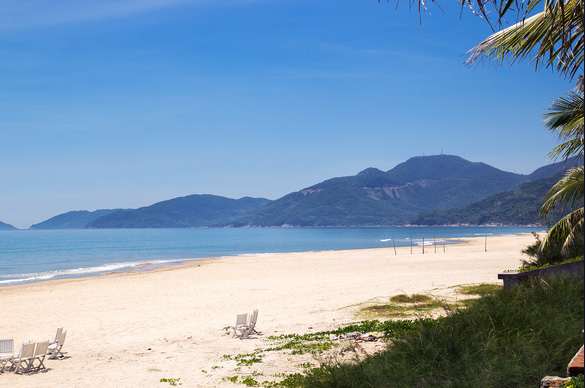
Non Nuoc Beach
Located near the Marble Mountains, Non Nuoc Beach is a pristine stretch of coastline known for its soft white sands and clear blue waters. It is a popular destination for relaxation and various water activities.
Activities:
- Swimming: Enjoy a refreshing swim in the calm, clear waters of Non Nuoc Beach.
- Sunbathing: Relax on the sandy shores and soak up the tropical sun.
- Water Sports: Engage in activities such as surfing, paddleboarding, and kayaking, suitable for all skill levels.
Highlights:
- Tranquil Environment: The beach offers a serene and uncrowded atmosphere, perfect for a peaceful getaway.
- Scenic Beauty: Stunning views of the Marble Mountains and the vast ocean horizon.
- Local Cuisine: Enjoy fresh seafood and local delicacies at nearby beachside restaurants.
Click here: Central Vietnam Wonders Tour
4. Hoa Nghiem Cave
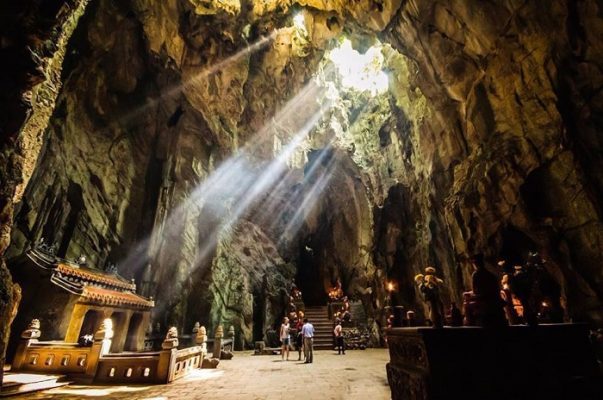
Hoa Nghiem Cave
Hoa Nghiem Cave is another significant cave within the Marble Mountains complex. It is known for its spiritual ambiance and the impressive statues of Buddha and Bodhisattvas inside.
Activities:
- Cave Exploration: Discover the natural formations and the sacred statues within the cave.
- Meditation: Experience a moment of tranquility and meditation in this serene environment.
- Photography: Capture the mystical beauty of the cave’s interior, illuminated by natural light.
Highlights:
- Statues of Buddha: Admire the large and beautifully crafted statues that add to the spiritual atmosphere of the cave.
- Peaceful Ambiance: The cave provides a quiet and reflective space away from the hustle and bustle of the city.
- Natural Formations: Marvel at the unique rock formations and the way light plays within the cave.
See more: Da Nang Attractions
VII. Travel Tips for Tourists
1. Best Time to Visit
The ideal times to visit Tam Thai Pagoda are during the spring and autumn seasons. During these periods, the weather in Da Nang is generally mild and pleasant, making it perfect for sightseeing and outdoor activities.
- Spring, from February to April, offers blooming flowers and vibrant greenery, creating a picturesque backdrop for your visit.
- Autumn, from September to November, provides cooler temperatures and less rainfall, ensuring a comfortable experience while exploring the pagoda and its surroundings.
2. Preparing for Your Trip
Appropriate Clothing: When visiting Tam Thai Pagoda, it’s important to dress respectfully. This means wearing modest clothing that covers your shoulders and knees. Lightweight, breathable fabrics are recommended due to the tropical climate. Additionally, comfortable walking shoes are essential, as you will likely be exploring various parts of the pagoda and its surroundings.
Essential Items:
- Water Bottle: Stay hydrated, especially if you visit during the warmer months.
- Sunscreen and Hat: Protect yourself from the sun’s rays while exploring the outdoor areas.
- Camera: Capture the beautiful architecture and scenic views.
- Umbrella or Raincoat: in case of unexpected rain showers, especially during the rainy season.
3. Local Cuisine
- Cao Lau: A unique noodle dish with influences from Chinese and Japanese cuisine, featuring thick noodles, pork, and fresh herbs.
- Banh Beo: small steamed rice cakes topped with shrimp, pork, and crispy shallots.
- Nam O Fish Salad: A refreshing raw fish salad with herbs, peanuts, and a tangy dressing.
Learn more about: Da Nang cuisine
In conclusion, Tam Thai Pagoda stands as a beacon of Vietnam’s rich cultural and spiritual heritage. Its historical significance, architectural beauty, and serene atmosphere make it a must-visit destination for tourists. Whether you are seeking a spiritual journey, a deep dive into history, or simply a peaceful retreat, Tam Thai Pagoda offers a unique and enriching experience. Plan your visit to explore the profound beauty and cultural depth of this ancient site.
Learn more about: Da Nang travel tips





